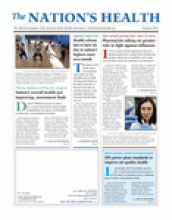While children of all ages need physical activity to stay healthy, a recent study finds that a range of barriers prevent child care centers from offering such activities.
The three main barriers to physical activity in child care centers are injury concerns, financial constraints and a focus on academic programming, according to the study.
The findings are particularly troubling in light of rising childhood obesity rates and the fact that three-fourths of U.S. preschool-aged children spend time in child care centers. Published in the February issue of Pediatrics, the study was based on focus groups held with 49 child care providers from 34 centers in Cincinnati.
“Societal priorities for young children — safety and school readiness — may be hindering children’s physical development,” the study’s authors wrote. “In designing environments that optimally promote children’s health and development, child advocates should think holistically about potential unintended consequences of policies.”
In recent years, stricter child care licensing codes have led to playgrounds becoming less physically challenging and interesting to children, the study found, and some parents have asked child care staff to restrict their children’s physical activity to reduce the risk of injury. And because many child care centers are running on tight budgets, those centers have limited ability to install abundant playground equipment.
Child care providers in the study told researchers they feel pressure from state mandates and from parents to focus on academics at the expense of gross motor play. Yet providing daily opportunities for exercise in child care centers is crucial, the study’s authors said, considering “children spend long hours in care, and many lack a safe place to play near their home.”
Earlier studies have found children spend 70 percent – 83 percent of their time in child care being sedentary, even when excluding naps and mealtime. And those children spend only 2 percent – 3 percent of their child care time engaging in vigorous activities.
“This is particularly concerning because daily physical activity is not only essential for healthy weight maintenance,” the study’s authors wrote,” but also for practicing and learning fundamental gross motor skills and socioemotional and cognitive skills.”
Many of the child care providers in the study expressed concern that time in child care may be the child’s only opportunity for outdoor play. That was particularly true for parents who worked multiple jobs or who did not earn sufficient income to afford outside extracurricular activities.
Safety concerns were cited most frequently as a concern for both parents and teachers that ended up being a barrier to physical activity.
“Participants relayed pressure from parents not to allow their children to get injured while under their watch,” the study’s authors wrote, “and at times were asked to keep children from participating in vigorous activity to keep them from being injured.”
The child care providers in the study complained that budgetary constraints, coupled with parents’ concerns about a focus on academics, made it more difficult to find time and space for physical activity. Many providers lacked a dedicated indoor gross motor room where children could be active during inclement weather, for example.
“In promoting optimally safe, healthy and enriched learning environments for young children, there may be a need to reset the balance between the salient priorities of injury prevention and kindergarten readiness with those that have not received as much attention, that is, physical activity promotion,” the study’s authors said. “Given that childhood obesity is quickly eclipsing childhood injury as a leading cause of morbidity, and that time in child care may be the child’s only opportunity for outdoor play, licensing standards may need to explicitly promote physical activity in as much detail as is devoted to safety.”
For more information, visit http://pediatrics.aappublications.org.
- Copyright The Nation’s Health, American Public Health Association









